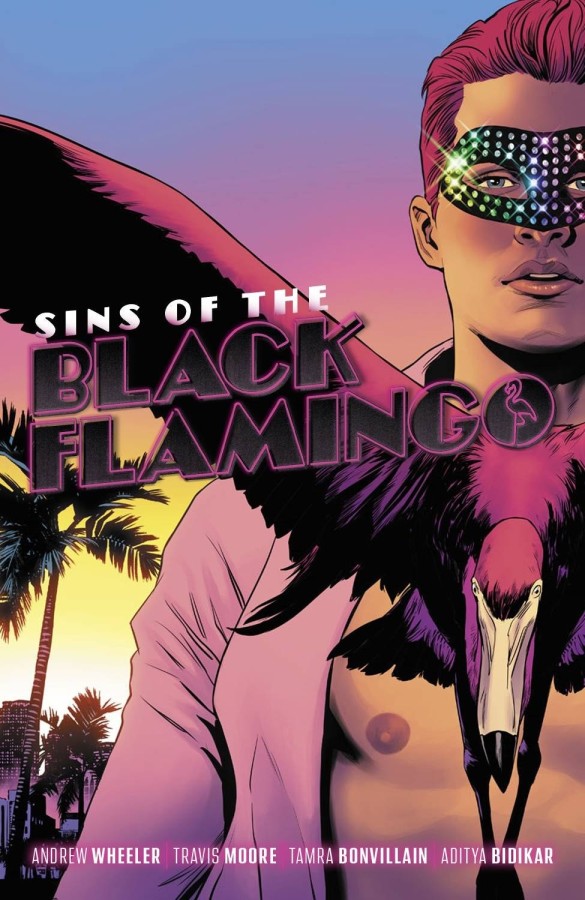Magical Crimes, Miami Style: On "Sins of the Black Flamingo"

And we're back. I'm a fan of crime comics and tales of the uncanny; this time around, here's a look at a book that encompasses both.
*
It’s a weird time to be a magical detective in the world of comics. Writer Si Spurrier’s acclaimed run on Hellblazer ended after twelve issues, prompting Spurrier to wrangle with the archetype in a new, creator-owned title, Damn Them All, in collaboration with longtime The Walking Dead artist Charlie Adlard. Constantine is far from alone in the realm of comic book heroes who seem equally informed by film noir and urban fantasy, but he casts a long shadow in the space.
That’s one of the many reasons why Sins of the Black Flamingo — from writer Andrew Wheeler and artist Travis Moore, the title’s creators — makes for especially interesting (and rewarding) reading. At its heart, it’s the story of a gentleman thief firmly ensconced in the occult underworld. Specifically, Miami’s occult underworld — this is a book in which the beaches stretch for miles, nearly every character is absurdly good-looking, and the palm trees are omnipresent.

Our hero (or anti-hero?) is Sebastian Harlow, the Black Flamingo of the title, a gentleman thief with a penchant for the occult. Years earlier, a harrowing encounter with a magical artifact gave him a glimpse of the nature of the universe; he’s very much in the category of heroes quick to make quips in order to guard against a bleaker awareness of the world around them.
Early in the book, Harlow pulls off a caper in space with a heavily loaded name: the Museum of American Heritage and Culture. “This place is mostly Confederate memorabilia, and who’s going to steal that?” he ponders. “Other, shittier racists?” It’s there that he makes off with an artifact that can return a golem to life, and sees signs of a larger conspiracy afoot.
It’s the latter that turns out to foreshadow the overarching plot of the book, in which Harlow winds up entangled with a wealthy man with a penchant for the occult, as well as a crew of people who do in fact meet the definition of “other, shittier racists.”
One of the wiser maneuvers Wheeler makes in telling this story is in centering Harlow’s narration, which both establishes his history in this city and gives a sense of his worldview. The storyline of this collection pits Harlow — a queer antihero whose closest friend is Ofelia, a Black woman with uncanny talents of her own — against a series of markedly reactionary foes, who seem all too familiar in the United States circa now. And while Harlow is miles apart from John Constantine in terms of their worldview, this book does share one quality with Hellblazer at its best: the notion of using these stories as a kind of political critique.
Travis Moore’s artwork is uniformly terrific throughout, and there’s a sequence that opens the book’s fourth chapter in which Moore’s art and Tamra Bonvillain’s colors memorably evoke Harlow making his way through several layers of consciousness. As befitting a book about a gentleman thief, the settings here are memorably detailed, whether they’re a party abounding with an elite clientele or swamplands where hungry creatures lurk.
It’s not too much of a spoiler to say that the ending leaves the door open for future stories with Harlow at the center. And if this one’s any indication, the Black Flamingo is a welcome addition to the comic-book landscape of magic-wielding antiheroes — and to the pantheon of uncanny forays into crime fiction.
As always, I'm Tobias Carroll, and this has been Postcards From Komiksoj.
This newsletter is free, but if you’re so inclined, I have a page at Ko-Fi where you can buy me a (metaphorical) cup of coffee. My novel In the Sight is available here, and details on upcoming readings can be found here.
If you're interested in buying any of the books reviewed in these pages, most of them can be ordered via Bookshop.